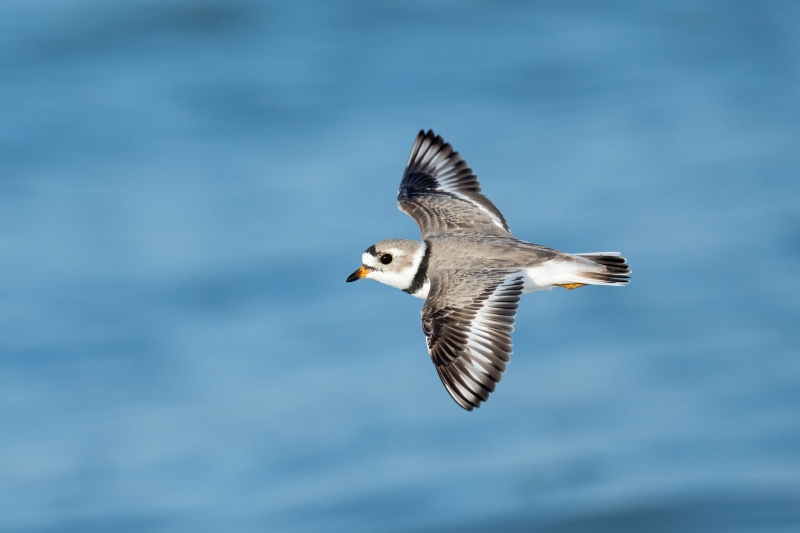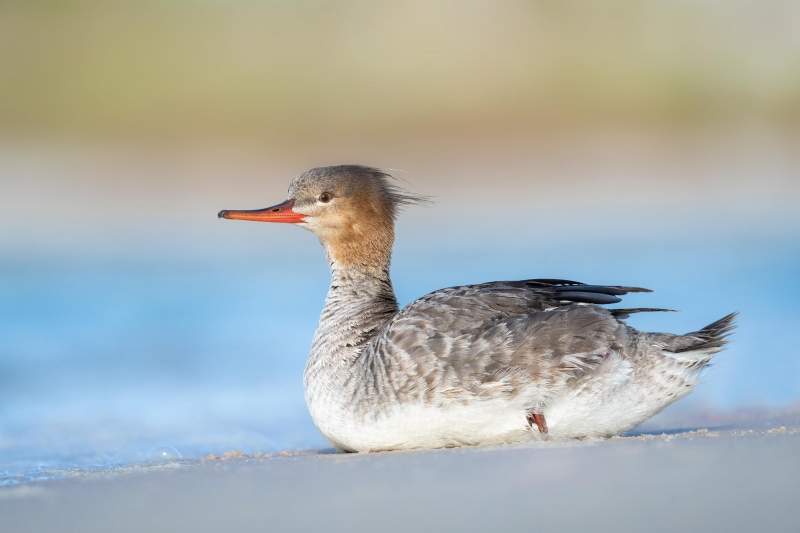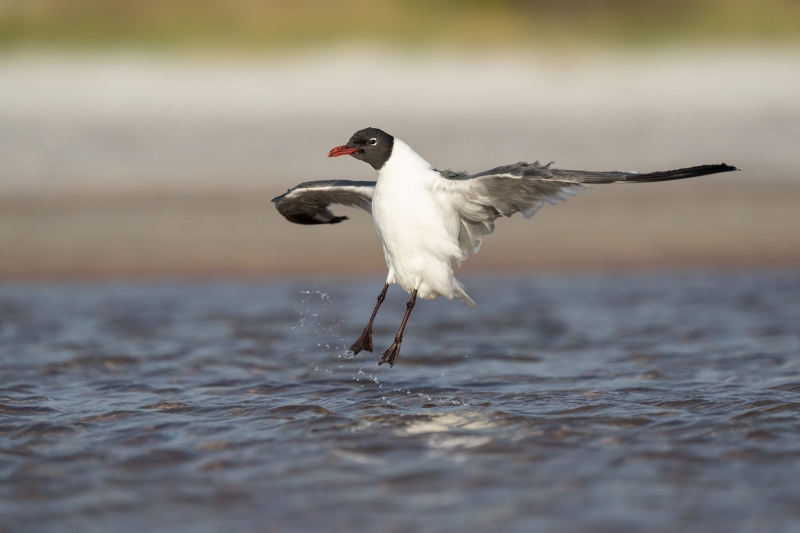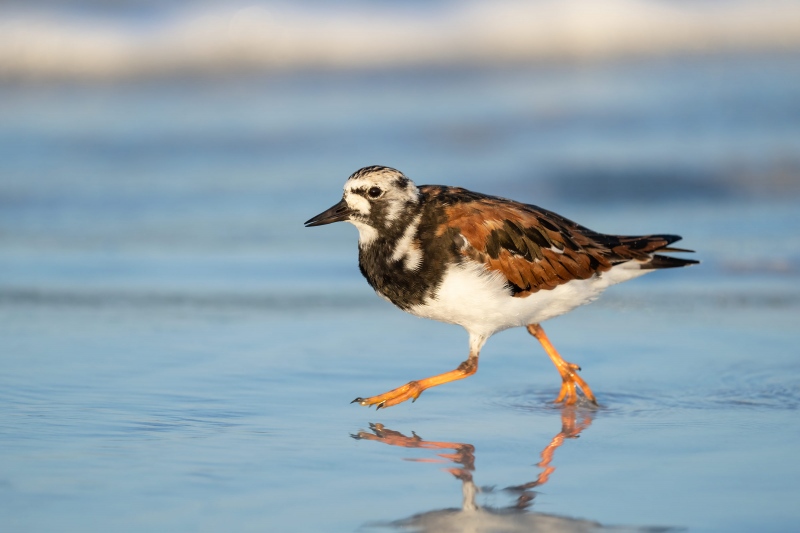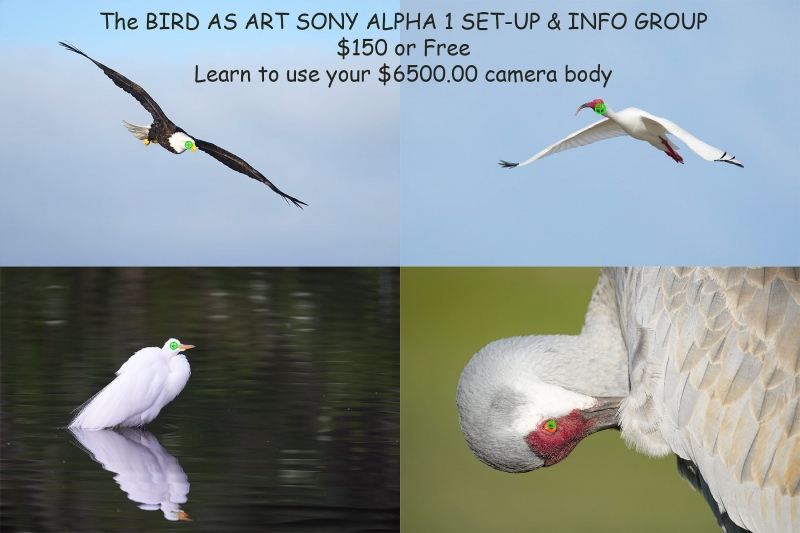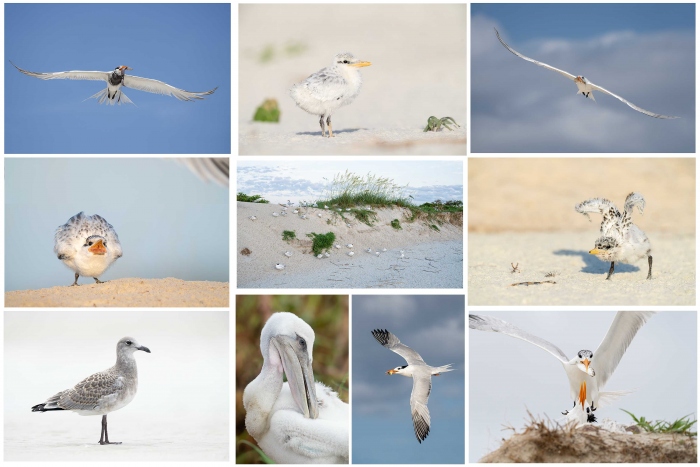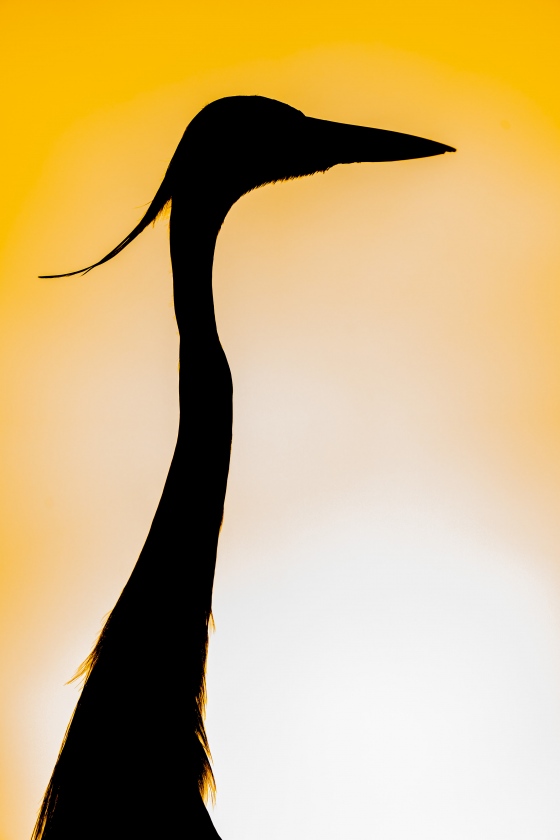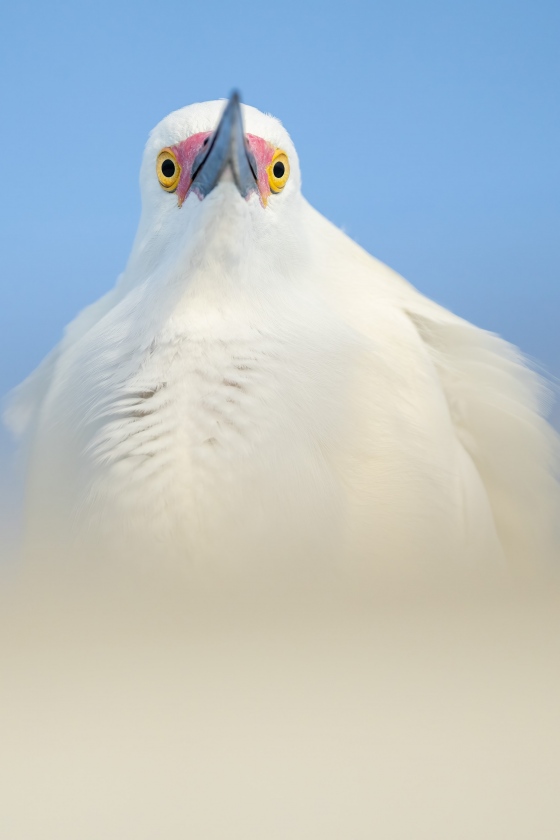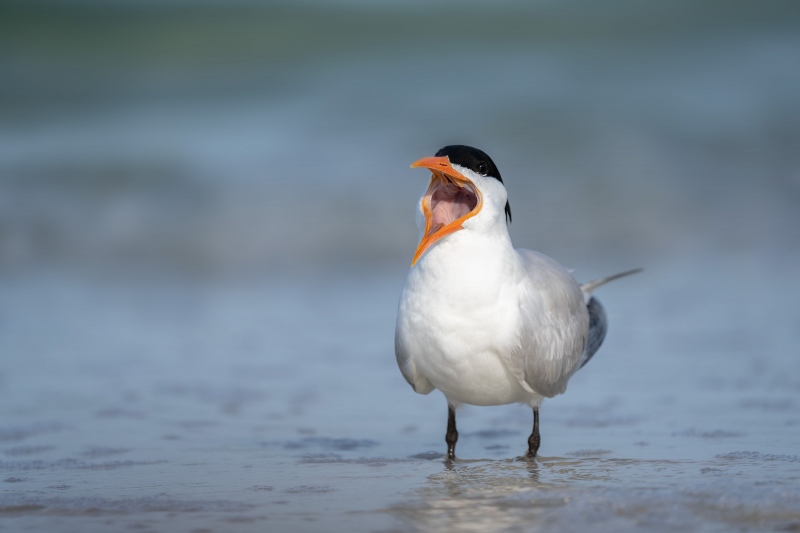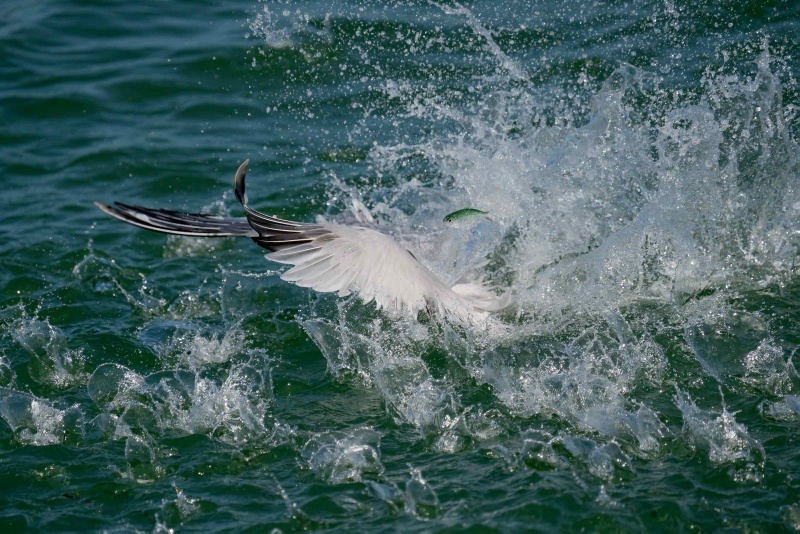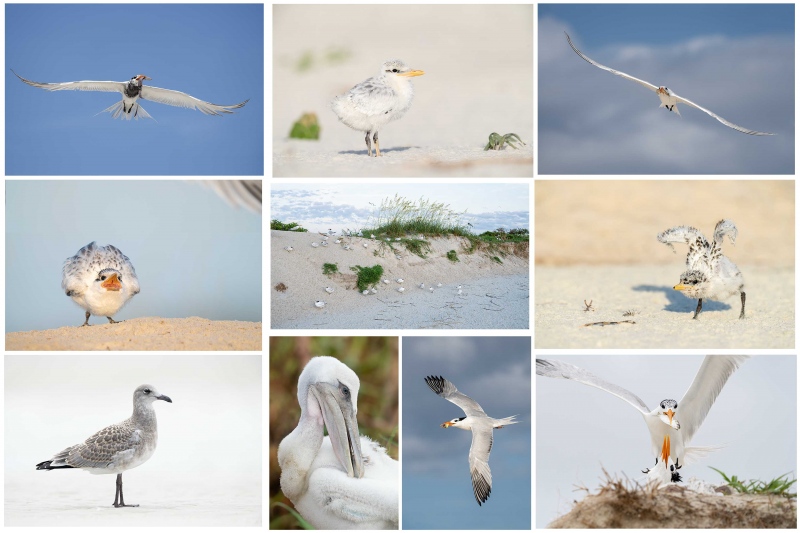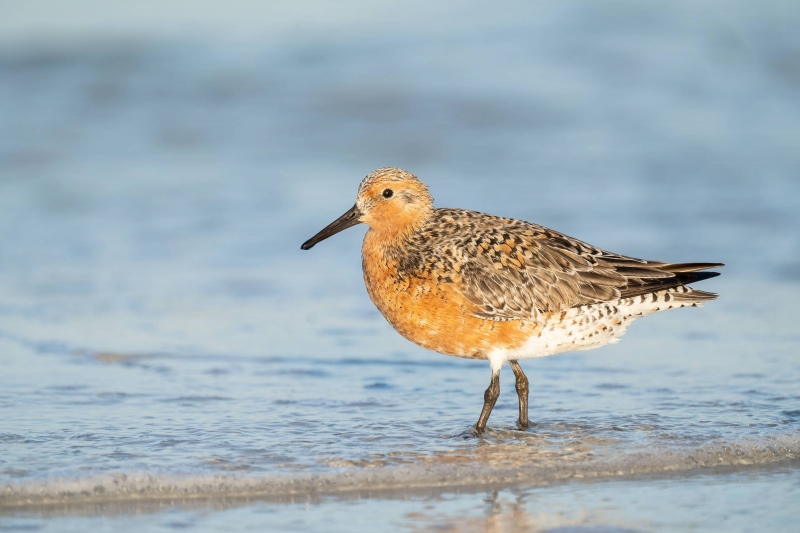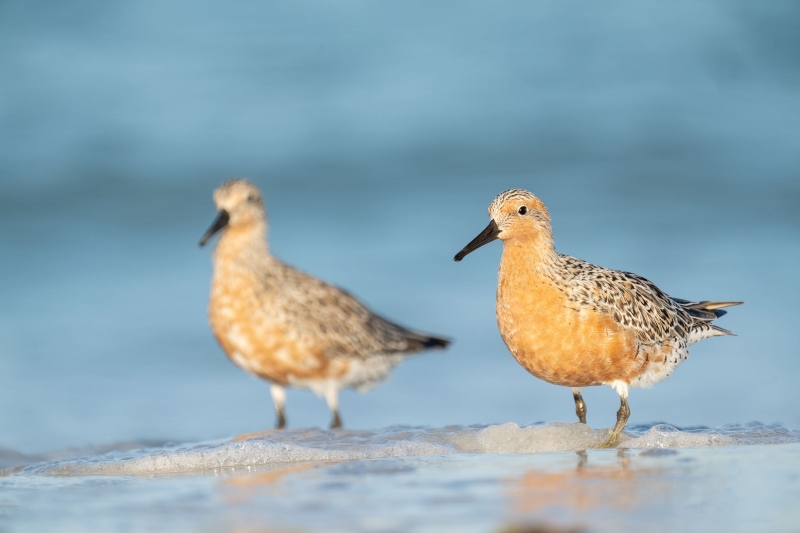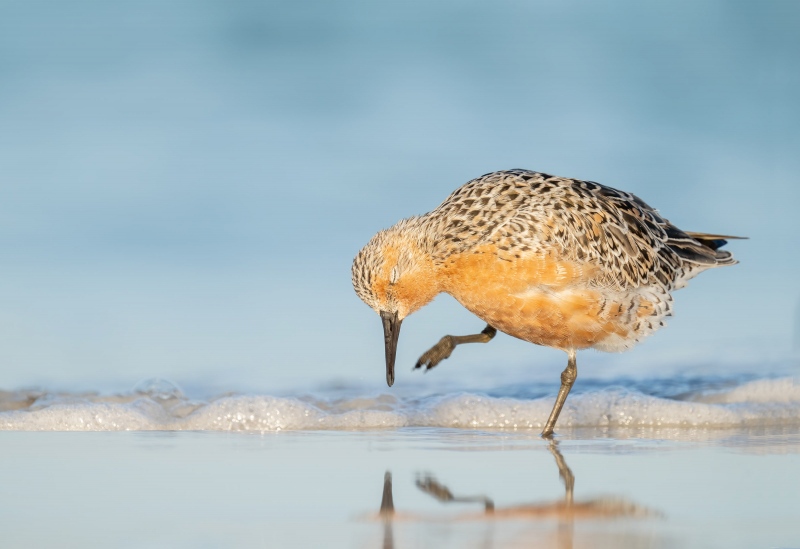April 29th, 2022 Your Favorite Image?
Which of today’s four featured and very different avian images is your favorite? All are invited to leave a comment and let us know why they made their choice.
Just for the Record
If you are not using a Sony a1 for bird photography, you are making your life far more difficult than it needs to be. Period.
What’s Up?
Me, still. Flying high and loving life. And this IPT group. Wednesday was a bit slow at our usual morning spot, so we hit the back-up location early. Things began slowly and it took me a while to come up with a plan, but once I figured out where we needed to be, we all made some excellent images of Snowy Egrets catching greenbacks under the pier and then flying back up to the railing. Story and images soon. Even better, I created two of the very best action images in 38+ years of trying. Thanks to Anita North, Anke Frohlich, and Sony. Photos and the whole story tomorrow.
I had my traditional last day lunch at the Neptune Grill — a big slice of their legendary peanut butter pie and a large glass of ice cold almond milk (unsweetened …) I took the group out for an early dinner at Pia’s Trattoria in Gulfport. DeSoto IPT regular Jim Miller had his favorite, the Homemade Lasagna, made with Pia’s Classic Bolognese Sauce Utilizing Grass Fed-Free Roaming Florida Beef and layers of Parmesan Béchamel served in a Cast Iron Skillet. I had mine: Parmigiana di Melanzane, Classic Layered Pan Fried Eggplant Served in a Skillet with Pomodoro Sauce, Mozzarella and Parmiggiano-Reggiano Cheese. New friend Peter Dominowksi enjoyed the Pesto Rosso: Spicy Sun-dried Tomatoes, Parmesan, Garlic and Italian Extra Virgin Olive Oil – Hand Ground into a Paste and then Tossed with Italian Penne Pasta. Brendan, the kid in the group, got to the restaurant, could not find our table, and headed to DeSoto. We did the same and found a cooperative Tricolored Heron. The wind from the east did not help our cause. We did OK at my favorite sunset spot and then headed for bed.
Today is Friday 29 April, the last morning of the 2022 DeSoto Spring IPT. Again, the forecast for the morning is for clear with a brisk east wind, perfect for bird photography. Wherever you are and whatever you are doing, I hope that you too have a great day. This blog post took about 90 minutes to prepare and makes forty-nine days in a row with a new one.
Please remember to use the B&H and Amazon links that are found on most blog pages and to use the BIRDSASART discount code at checkout when purchasing your new gear from Bedfords. Please, also, consider joining a BAA IPT. You will be amazed at how much you will learn!
BIRDS AS ART Image Optimization Service (BAA IOS)
Send a PayPal for $62.00 to birdsasart@verizon.net or call Jim at 863-692-0906 and put $62.00 on your credit card. Pick one of your best images and upload the raw file using a large file sending service like Hightail or DropBox and then send me the link via e-mail. I will download and save your raw file, evaluate the exposure and sharpness, and optimize the image as if it were my own after converting the raw file in Adobe Camera Raw. Best of all, I will make a screen recording of the entire process and send you a link to the video to download, save and study.
|
|
|
This image was created on 26 April on the Spring 2022 Fort DeSoto Park IPT. While standing along the edge of the surf I used the hand held Sony FE 200-600mm f/5.6-6.3 G OSS lens (at 600mm) and The One, the Sony Alpha 1 Mirrorless digital camera. ) The exposure for Royal Terns in flight was determined using Zebra technology with ISO on the Thumb Dial. ISO 800. 1/4000 second at f/6.3 (wide-open) in Manual Mode. AWB at 8:03:52am on a mostly clear morning. RawDigger showed the exposure for this Piping Plover to be 2/3 stop too dark.
Tracking: Zone AF-C with Bird Face/Eye Detection performed perfectly. Be sure to click on the image to enjoy a high-res version.
Image #1: Piping Plover in flat flight
|
Is That My Image?
Without the Sony a1 in my hands I could never have dreamed of creating a razor-sharp image of a small, fast shorebird in flight. I do not have the physical tools to make such images consistently, but once in a while, I can do it. In addition, the 200-600 lens is an incredible tool for creating images of flying and running shorebirds.
I was set up for images of the brighter, whiter Royal Terns. When the endangered plover flew by, I did not have time to fiddle with the exposure. I made a series of eight images that included one special one.
|
|
|
This image was created on 26 April on the Spring 2022 Fort DeSoto Park IPT. Using the ankle-pod technique while seated, I worked with the hand held Sony FE 200-600mm f/5.6-6.3 G OSS lens (at 553mm) and The One, the Sony Alpha 1 Mirrorless digital camera. ) The exposure was determined using Zebra technology with ISO on the Thumb Dial. ISO 800. 1/1000 second at f/6.3 (wide-open) in Manual Mode. AWB at 6:25:24pm on a mostly sunny afternoon. RawDigger showed the exposure to be perfect.
Tracking: Spot S AF-C with Bird Face/Eye Detection performed perfectly. Be sure to click on the image to enjoy a high-res version.
Image #2: Red-breasted Merganser winter plumage female hauled out
|
Working the Subject
My eyes lit up when I saw this merganser hauled out on the sand. I sat down while a good distance from the bird and advanced slowly with my rig on my lap by pushing myself forward with my fists. Fun in the wet mud. But it got the job done. For this one I had to zoom out a bit to give the bird enough room in the frame.
|
|
|
This image was created on 27 April on the Spring 2022 Fort DeSoto Park IPT. Again, I used the ankle-pod technique with the hand held Sony FE 200-600mm f/5.6-6.3 G OSS lens (at 529mm) and The One, the Sony Alpha 1 Mirrorless digital camera. ) The exposure was determined using Zebra technology with ISO on the Thumb Dial. ISO 800. 1/4000 second at f/6.3 (wide-open) in Manual Mode. AWB at 6:44:29pm on a mostly sunny afternoon. RawDigger showed the exposure to be perfect.
Tracking: Spot S AF-C with Bird Face/Eye Detection performed perfectly. Be sure to click on the image to enjoy a high-res version.
Image #3: Laughing Gull jumping up after bath
|
The Ankle-pod Technique
The more I use, practice, and teach the ankle-pod technique, the better the results. Right now, I have the technique pretty much perfected. It is so effective that I rarely bring a Panning Ground-Pod into the field anymore. For the flapping after bath shots, I set the shutter speed to at least 1/2000 second. Working off the tilted rear monitor and trusting the a1’s AF system, I can follow the birds and frame the image with the lens on my ankle as they jump into the air after a bath.
I learned on Wednesday that if a tern or a gull fills about 1/3 to 1/2 of the frame at 600mm (with the 200-600), that I can avoid clipping the wings most of the time when they flap by zooming out to 500mm or a bit more. I can now class myself as deadly when using the ankle-pod technique. And best of all, I can teach you to become proficient with it. Join me in Jacksonville to learn to perfect your ankle-podding.
|
|
|
This image was created on 28 April on the Spring 2022 Fort DeSoto Park IPT. While seated, I used the hand held Sony FE 200-600mm f/5.6-6.3 G OSS lens (at 600mm) and The One, the Sony Alpha 1 Mirrorless digital camera. ) The exposure was determined using Zebra technology with ISO on the Thumb Dial. ISO 1000. 1/1600 second at f/6.3 (wide-open) in Manual Mode. AWB at 7:29:06am on a sunny morning. RawDigger showed the exposure to be dead-solid perfect.
Tracking: Zone AF-C with Bird Face/Eye Detection performed perfectly. Be sure to click on the image to enjoy a high-res version.
Image #4: Ruddy Turnstone male running on the edge of the surf
|
Getting Up Early
We got to the beach very early and headed straight to the Gulf in hopes of finding a few flocks of Red Knots. But there were only Sanderlings and turnstones. Most of the birds were working from right to left as they fed along the edge of the surf. We would get ahead of the birds and ahead of sun angle, sit on the wet sand, and let the birds work their way to us. Oftentimes they would sense our presence and begin to run. In those situations, the a1 is at its best. With Tracking: Zone, the AF system tracks the face or the eye accurately.
200-600 Versatility
Take a moment to consider the variety and quality of the eight images featured in the last two blog posts. When I do that, I am astounded. Then add the 1.4X TC and consider the Red Knot images in Tuesday’s blog post …
|
|
|
Click on the image to better see the green eye-AF boxes in action.
Sony Alpha 1 Flight Photography AF Points!
|
The SONY Alpha a1 Set-up Guide and Info Group: $150.00 (or Free)
The SONY Alpha a1 Set-up Guide and Info Group is going great guns as more and more folks chime in with thoughtful questions and experience-based answers. As the a1 is becoming more readily available, more and more folks are getting their hands on this amazing body. By early April, the group was up to an astounding 115 lucky and blessed folks. Early on, we discussed the myriad AF options. I gave my opinion as to the best one for flight and general bird photography. The best news is that everyone in the group receives an e-mail that includes a .DAT file with my a1 settings on it, and explicit directions on how to load my settings onto your a1; talk about convenience! I am now offering a .DAT file compatible with firmware update 1.20. Your entry into the group includes a consolidated Sony a1 CAMSETA2 INFO & GUIDE. New a1 folks will now receive four e-mails instead of the previous 28! You will see new e-mails as they are published. Simply put, this e-mail guide is an incredible resource for anyone with an a1.
All who purchased their Alpha 1 bodies via a BAA affiliate link — B&H or Bedfords — will receive a free Sony Alpha a1 Set-Up Guide and free entry into the Info Updates group after shooting me their receipts via e-mail. (Note: it may take me several days to confirm B&H orders.). Others can purchase their guide here in the BAA Online Store.
|
|
|
Click on the composite image to enjoy the incredible quality of the hi-res JPEG.
Clockwise from upper left clockwise and back around to the center: Royal Tern in flight with squid for chick; Royal Tern chick on beach; Royal Tern in flight with shrimp for young; Royal Tern chick — double overhead wing stretch; Royal Tern landing with greenback for chick; Royal Tern in flight with juvenile mahi mahi for chick; Brown Pelican — large chick preening; Laughing Gull in fresh juvenal plumage; Royal Tern chick begging; Many Royal Terns with many chicks on face of dune.
|
Jacksonville IPT: #1: 4 FULL DAYS — the afternoon of 16 June thru the morning of MON 20 June 2022: $2,099.00. (Limit 6 photographers)
Jacksonville IPT #2: the afternoon of FRI 1 JULY thru the morning of TUES 5 July 2022: $2099.00 (Limit 6 photographers)
Jacksonville IPT #3: the afternoon of FRI 15 JULY thru the morning of TUES 19 July 2022: $2099.00 (Limit 6 photographers)
Ride with me: add $200.00. I do not like to disappoint: each trip will run with one participant. If necessary.
I first visited the breeding bird colony at Jacksonville in late June 2021. I was astounded. There were many thousands of pairs of Royal Terns nesting along with about 10,000 pairs of Laughing Gulls. In addition to the royals, there were some Sandwich Terns nesting. And there are several dozen pairs of Brown Pelicans nesting on the ground. Flight photography was non-stop astounding. And photographing the tern chicks was relatively easy. Folks could do the whole trip with the Sony 200-600, the Canon 100-500 RF, or the Nikon 500 PF or 200-500 VR. With a TC in your pocket for use on sunny days. Most of the action is within 100 yards of where we park (on the beach). As with all bird photography, there are times when a super-telephoto lens with either TC is the best tool for the job.
Morning sessions will average about three hours, afternoon sessions about 1 1/2 hours. On cloudy mornings with favorable winds, we may opt to stay out for one long session and skip the afternoon, especially when the afternoon forecast is poor. Lunch is included on the first three days of the IPT and will be served at my AirBnB. After the first lunch there will be an introductory program. On days two and three we will do image review and Photoshop after lunch.
We will be based somewhere west and a bit north of Jacksonville where there are many AirBnB possibilities. The deposit is $599.00. Call Jim at the office any weekday at 863-692-0906 to pay by credit card. Balances must be paid by check.
What You Will Learn on a Jacksonville IPT
- 1- First and foremast you will learn to become a better flight photographer. Much better.
- 2-You will learn the basics and fine points of digital exposure. Nikon and Canon folks will learn to get the right exposure every time after making a single test exposure, and SONY folks will learn to use Zebras so that they can be sure of making excellent exposures before pressing the shutter button.
- 3- You will learn to work in Manual exposure mode even if you fear it.
- 4- You will learn to evaluate wind and sky conditions and understand how they affect bird photography, especially the photography of birds in flight.
- 5- You will learn several pro secrets (for each system) that will help you to become a better flight photographer.
- 6- You will learn to zoom out in advance (because the birds are so close!) 🙂
- 7- You will learn how to approach free and wild birds without disturbing them.
- 8- You will learn to spot the good and the great situations.
- 9- You will learn to understand and predict bird behavior.
- 10- You will learn to design pleasing images by mastering your camera’s AF system.
- 11- You will learn to choose the best perspective.
- 12- You will learn to see and control your backgrounds.
- 13- You will learn to see and understand the light.
- 14- You will learn to see and create pleasing blurs in pre-dawn situations.
- 15- You will learn to be ready for the most likely event.
And the best news is that you will be able to take everything you learn home with you so that you will be a better photographer wherever you are and whenever you photograph.
Typos
With all blog posts, feel free to e-mail or to leave a comment regarding any typos or errors.
April 28th, 2022 Your Favorite Image?
Which of today’s four featured and very different avian images is your favorite? All are invited to leave a comment and let us know why they made their choice.
Just for the Record
If you are not using a Sony a1 for bird photography, you are making your life far more difficult than it needs to be. Period.
What’s Up?
Me. High as a kite and loving life after another great IPT day at DeSoto. It was not quite as great as Tuesday had been, but we had lots of excellent chances and ended with a killer sunset and a bird on a perch (that took a while to develop).
Today is Thursday 28 April, Day 3 of the 2022 DeSoto Spring IPT. Again, the forecast is for partly cloudy in the morning with a NE breeze. Wherever you are and whatever you are doing, I hope that you too have a great day. This blog post took about 90 minutes to prepare and makes forty-eight days in a row with a new one.
Please remember to use the B&H and Amazon links that are found on most blog pages and to use the BIRDSASART discount code at checkout when purchasing your new gear from Bedfords. Please, also, consider joining a BAA IPT. You will be amazed at how much you will learn!
BIRDS AS ART Image Optimization Service (BAA IOS)
Send a PayPal for $62.00 to birdsasart@verizon.net or call Jim at 863-692-0906 and put $62.00 on your credit card. Pick one of your best images and upload the raw file using a large file sending service like Hightail or DropBox and then send me the link via e-mail. I will download and save your raw file, evaluate the exposure and sharpness, and optimize the image as if it were my own after converting the raw file in Adobe Camera Raw. Best of all, I will make a screen recording of the entire process and send you a link to the video to download, save and study.
And Please Remember
You can find some great photo accessories (and necessities, like surf booties!) on Amazon by clicking on the Stuff tab on the orange/yellow menu bar above. On a related note, it would be extremely helpful if blog-folks who, like me, spend too much money on Amazon, would get in the habit of clicking on the Amazon logo link on the right side of each blog post when they shop online. As you might expect, doing so will not cost you a single penny, but would be appreciated tremendously by yours truly. And doing so works seamlessly with your Amazon Prime account.
Please remember that if an item — a Delkin flash card, or a tripod head — for example, that is available from B&H and/or Bedfords, is also available in the BAA Online Store, it would be great, and greatly appreciated, if you would opt to purchase from us. We will match any price. Please remember also to use my B&H affiliate links or to earn 3% cash back at Bedfords by using the BIRDSASART discount code at checkout for your major gear purchases. Doing either often earns you free guides and/or discounts. And always earns my great appreciation.
Brand-New and As-Good-As-Ever Bedfords BAA Discount Policy
Folks who have fallen in love with Bedfords can now use the BIRDSASART coupon code at checkout to enjoy a post-purchase, 3% off-statement credit (excluding taxes and shipping charges) on orders paid with a credit card. The 3% credit will be refunded to the card you used for your purchase. Be sure, also, to check the box for free shipping to enjoy free Second Day Air Fed-Ex. This offer does not apply to purchases of Classes, Gift Cards, or to any prior purchases.
Money Saving Reminder
Many have learned that if you need a hot photo item that is out of stock at B&H and would like to enjoy getting 3% back on your credit card along with free 2nd Day Air Fed-Ex Air shipping, your best bet is to click here, place an order with Bedfords, and enter the coupon code BIRDSASART at checkout. If an item is out of stock, contact Steve Elkins via e-mail or on his cell phone at (479) 381-2592 (Central time). Be sure to mention the BIRDSASART coupon code and check the box for Free Shipping. That will automatically upgrade to free 2nd Day Air Fed-Ex. Steve has been great at getting folks the hot items that are out of stock at B&H and everywhere else. The waitlists at the big stores can be a year or longer for the hard-to-get items. Steve will surely get you your gear long before that. For the past year, he has been helping BAA Blog folks get their hands on items like the SONY a 1, the SONY 200-600 G OSS lens, the Canon EOS R5, the Canon RF 100-500mm lens, and the Nikon 500mm PF. Steve is personable, helpful, and eager to please.
Important Note
As an Amazon Associate, I earn a small percentage when you purchase from Amazon after using any of the Amazon links on the blog (including the logo-link immediately above). My link works with Amazon Prime and using it will not cost you a single cent. Huge thanks, BTW 🙂
Please Remember Also
Please, if you enjoy and learn from the blog, remember to use one of my two affiliate programs when purchasing new gear. Doing so just might make it possible for me to avoid having to try to get a job as a Walmart greeter and will not cost you a single penny more. And if you use Bedfords and remember to enter the BIRDSASART code at checkout, you will (still!) save 3% on every order and enjoy free second-day air shipping. In these crazy times — I lost about fifty thousand dollars in income due to COVID 19 — remembering to use my B&H link or to shop at Bedfords will help me out a ton and be greatly appreciated. Overseas folks who cannot order from the US because of import fees, duties, and taxes, are invited to help out by clicking here to leave a blog thank you gift if they see fit.


Gear Questions and Advice
Too many folks attending BAA IPTs and dozens of photographers whom I see in the field and on BPN, are–out of ignorance–using the wrong gear, especially when it comes to tripods and more especially, tripod heads… Please know that I am always glad to answer your gear questions via e-mail. If you are desperate, you can try me on my cell at 863-221-2372. Please leave a message and shoot me a text if I do not pick up.
|
|
|
This image was created on 27 April 2022 at Fort DeSoto Park in Pinellas County, FL. I used the hand held Sony FE 200-600mm f/5.6-6.3 G OSS lens (at 600mm) and The One, the Sony Alpha 1 Mirrorless digital camera. ) The exposure was determined using Zebra technology with ISO on the Thumb Dial. ISO 1250. 1/5000 second at f/6.3 (wide-open) in Manual Mode. AWB at 7:54:27am on a clear morning. RawDigger showed the exposure to be just a bit too bright.
Upper Center Tracking: Zone AF-C with Bird Face/Eye Detection performed perfectly. Be sure to click on the image to enjoy a high-res version.
Image #1: Great Blue Heron hazy morning silhouette
|
Dramatic Hazy Sky Silhouettes
When there is a hazy sun, the seemingly white sky near the sun can provide dramatic silhouette opportunities. Had I shot this one a bit darker, I could have made the whole sky gold in post-processing. But I like the abstract look. And love the gold at the top of the frame. The trick with these is to not include the hazy sun in the frame.
|
|
|
This image was created on 27 April 2022 at Fort DeSoto Park in Pinellas County, FL. I used the hand held Sony FE 200-600mm f/5.6-6.3 G OSS lens (at 600mm) and The One, the Sony Alpha 1 Mirrorless digital camera. ) The exposure was determined using Zebra technology with ISO on the Thumb Dial. ISO 1600. 1/2000 second at f/6.3 (wide-open) in Manual Mode. AWB at 7:38:05am on a clear morning. RawDigger showed the exposure to be perfect.
Tracking: Zone AF-C with Bird Face/Eye Detection performed perfectly. Be sure to click on the image to enjoy a high-res version.
Image #2: Snowy Egret breeding plumage in heaven
|
Lens Pointed Up at a Wading Bird
I first patented this type of image when I got down on the ground at the Sanibel Fishing Pier to photograph the binocular vision of a Great Egret about three decades ago. The shot is available at many locations where herons and egret perch atop various structures. The out-of-focus metal roof in Image #2 provided the bird-in-heaven look. As with Image #1, good images are where you see them. Join an IPT to improve your creative vision.
|
|
|
This image was created on 27 April 2022 at Fort DeSoto Park in Pinellas County, FL. I used the ankle-pod technique with the hand held Sony FE 200-600mm f/5.6-6.3 G OSS lens (at 600mm) and The One, the Sony Alpha 1 Mirrorless digital camera. ) The exposure was determined using Zebra technology with ISO on the Thumb Dial. ISO 640. 1/2500 second at f/6.3 (wide-open) in Manual Mode. AWB at 8:38:12am on a then-hazy morning. RawDigger showed the exposure to be perfect.
Tracking: Zone AF-C with Bird Face/Eye Detection performed perfectly. Be sure to click on the image to enjoy a high-res version.
Image #3: Royal Tern yawning
|
The Ankle-pod Technique
The more I use, practice, and teach the ankle-pod technique, the better the results. Right now, I have the technique pretty much perfected. It is so effective that I rarely bring a Panning Ground-Pod into the field anymore. If I have my reading glasses along, toggle the level on and off on the rear monitor, and work at shutter speeds of at least 1/250 second, I can routinely create excellent eye-level images of birds on the ground. I can now class myself as deadly when using the ankle-pod technique. And best of all, I can teach you to become proficient with it. Join me in Jacksonville to learn how and to perfect your ankle-podding.
|
|
|
This image was created on 26 April 2022 at Fort DeSoto Park in Pinellas County, FL. I used the ankle-pod technique with the hand held Sony FE 200-600mm f/5.6-6.3 G OSS lens (at 600mm) and The One, the Sony Alpha 1 Mirrorless digital camera. ) The exposure was determined using Zebra technology with ISO on the Thumb Dial. ISO 640. 1/4000 second at f/6.3 (wide-open) in Manual Mode. AWB at 9:58:29am on a sunny morning. RawDigger showed the exposure to be dead-solid perfect.
Tracking: Zone AF-C with Bird Face/Eye Detection performed perfectly. Be sure to click on the image to enjoy a high-res version.
Image #4: Royal Tern fishing mayhem
|
A Near-Impossible Situation
There were huge schools of greenbacks. But there was only one spot where we could get on sun angle. Laughing Gulls and Royal and Sandwich Terns would circle and approach from our right while flying low over the water, only occasionally smacking into the water to grab a fish. And a Brown Pelican or two joined in on the fun. But photography was extremely difficult. Once I acquired focus, I would begin firing in hopes of capturing a chaotic scene. Obviously, had lots of images to delete. The biggest problem was that in most cases when the birds would hit the water, their forward motion would stop but you would keep panning …
In Image #4, I love the mayhem and the single baitfish suspended in midair. It almost looks as if the tiny greenback were attacking the tern!
|
|
|
Click on the image to better see the green eye-AF boxes in action.
Sony Alpha 1 Flight Photography AF Points!
|
The SONY Alpha a1 Set-up Guide and Info Group: $150.00 (or Free)
The SONY Alpha a1 Set-up Guide and Info Group is going great guns as more and more folks chime in with thoughtful questions and experience-based answers. As the a1 is becoming more readily available, more and more folks are getting their hands on this amazing body. By early April, the group was up to an astounding 115 lucky and blessed folks. Early on, we discussed the myriad AF options. I gave my opinion as to the best one for flight and general bird photography. The best news is that everyone in the group receives an e-mail that includes a .DAT file with my a1 settings on it, and explicit directions on how to load my settings onto your a1; talk about convenience! I am now offering a .DAT file compatible with firmware update 1.20. Your entry into the group includes a consolidated Sony a1 CAMSETA2 INFO & GUIDE. New a1 folks will now receive four e-mails instead of the previous 28! You will see new e-mails as they are published. Simply put, this e-mail guide is an incredible resource for anyone with an a1.
All who purchased their Alpha 1 bodies via a BAA affiliate link — B&H or Bedfords — will receive a free Sony Alpha a1 Set-Up Guide and free entry into the Info Updates group after shooting me their receipts via e-mail. (Note: it may take me several days to confirm B&H orders.). Others can purchase their guide here in the BAA Online Store.
|
|
|
Click on the composite image to enjoy the incredible quality of the hi-res JPEG.
Clockwise from upper left clockwise and back around to the center: Royal Tern in flight with squid for chick; Royal Tern chick on beach; Royal Tern in flight with shrimp for young; Royal Tern chick — double overhead wing stretch; Royal Tern landing with greenback for chick; Royal Tern in flight with juvenile mahi mahi for chick; Brown Pelican — large chick preening; Laughing Gull in fresh juvenal plumage; Royal Tern chick begging; Many Royal Terns with many chicks on face of dune.
|
Jacksonville IPT: #1: 4 FULL DAYS — the afternoon of 16 June thru the morning of MON 20 June 2022: $2,099.00. (Limit 6 photographers)
Jacksonville IPT #2: the afternoon of FRI 1 JULY thru the morning of TUES 5 July 2022: $2099.00 (Limit 6 photographers)
Jacksonville IPT #3: the afternoon of FRI 15 JULY thru the morning of TUES 19 July 2022: $2099.00 (Limit 6 photographers)
Ride with me: add $200.00. I do not like to disappoint: each trip will run with one participant. If necessary.
I first visited the breeding bird colony at Jacksonville in late June 2021. I was astounded. There were many thousands of pairs of Royal Terns nesting along with about 10,000 pairs of Laughing Gulls. In addition to the royals, there were some Sandwich Terns nesting. And there are several dozen pairs of Brown Pelicans nesting on the ground. Flight photography was non-stop astounding. And photographing the tern chicks was relatively easy. Folks could do the whole trip with the Sony 200-600, the Canon 100-500 RF, or the Nikon 500 PF or 200-500 VR. With a TC in your pocket for use on sunny days. Most of the action is within 100 yards of where we park (on the beach). As with all bird photography, there are times when a super-telephoto lens with either TC is the best tool for the job.
Morning sessions will average about three hours, afternoon sessions about 1 1/2 hours. On cloudy mornings with favorable winds, we may opt to stay out for one long session and skip the afternoon, especially when the afternoon forecast is poor. Lunch is included on the first three days of the IPT and will be served at my AirBnB. After the first lunch there will be an introductory program. On days two and three we will do image review and Photoshop after lunch.
We will be based somewhere west and a bit north of Jacksonville where there are many AirBnB possibilities. The deposit is $599.00. Call Jim at the office any weekday at 863-692-0906 to pay by credit card. Balances must be paid by check.
What You Will Learn on a Jacksonville IPT
- 1- First and foremast you will learn to become a better flight photographer. Much better.
- 2-You will learn the basics and fine points of digital exposure. Nikon and Canon folks will learn to get the right exposure every time after making a single test exposure, and SONY folks will learn to use Zebras so that they can be sure of making excellent exposures before pressing the shutter button.
- 3- You will learn to work in Manual exposure mode even if you fear it.
- 4- You will learn to evaluate wind and sky conditions and understand how they affect bird photography, especially the photography of birds in flight.
- 5- You will learn several pro secrets (for each system) that will help you to become a better flight photographer.
- 6- You will learn to zoom out in advance (because the birds are so close!) 🙂
- 7- You will learn how to approach free and wild birds without disturbing them.
- 8- You will learn to spot the good and the great situations.
- 9- You will learn to understand and predict bird behavior.
- 10- You will learn to design pleasing images by mastering your camera’s AF system.
- 11- You will learn to choose the best perspective.
- 12- You will learn to see and control your backgrounds.
- 13- You will learn to see and understand the light.
- 14- You will learn to see and create pleasing blurs in pre-dawn situations.
- 15- You will learn to be ready for the most likely event.
And the best news is that you will be able to take everything you learn home with you so that you will be a better photographer wherever you are and whenever you photograph.
Typos
With all blog posts, feel free to e-mail or to leave a comment regarding any typos or errors.
April 27th, 2022 Your Favorite Image?
Which of today’s three featured Red Knot images is your favorite? All are invited to leave a comment and let us know why they made their choice.
Just for the Record
If you are not using a Sony a1 for bird photography, you are making your life far more difficult than it needs to be. Period.
What’s Up?
When I crawled into bed after 9:00pm on Tuesday evening, I had one thought: What a great day to have been alive!
The first morning of the Spring 2022 Instructional Photo-Tour was beyond anything I could have dreamed of. Every year I tire of the “there are no birds at DeSoto” reports. Keep reading to learn what we experienced that morning. The afternoon, that ended with a dozen spoonbills, was one of my best DeSoto afternoons ever. But that is another story.
Today is Wednesday 27 April 2022. The forecast for St. Pete in the morning is not quite as good as it was on Tuesday morning, but partly cloudy with a light northeast breeze is nothing to sneeze at. Wherever you are and whatever you are doing, I hope that you too have a great day. This blog post took about an hour to prepare and makes forty-seven days in a row with a new one.
Please remember to use the B&H and Amazon links that are found on most blog pages and to use the BIRDSASART discount code at checkout when purchasing your new gear from Bedfords. Please, also, consider joining a BAA IPT. You will be amazed at how much you will learn!
BIRDS AS ART Image Optimization Service (BAA IOS)
Send a PayPal for $62.00 to birdsasart@verizon.net or call Jim at 863-692-0906 and put $62.00 on your credit card. Pick one of your best images and upload the raw file using a large file sending service like Hightail or DropBox and then send me the link via e-mail. I will download and save your raw file, evaluate the exposure and sharpness, and optimize the image as if it were my own after converting the raw file in Adobe Camera Raw. Best of all, I will make a screen recording of the entire process and send you a link to the video to download, save and study.
|
|
|
This image was created on 26 April at Fort DeSoto Park in Pinellas County, FL. I used the hand held Sony FE 200-600mm f/5.6-6.3 G OSS lens with the Sony FE 1.4x Teleconverter (at 840mm) with the One, the Sony a1 Mirrorless Camera. ISO 1000. Exposure determined via Zebras with ISO on the Thumb Wheel: RawDigger showed that the raw file brightness was dead solid perfect: 1/1000 sec. at f/9 (wide open) in Manual mode. AWB at 7:48:30am on a clear sunny morning.
Tracking: Spot S/AF-C with Bird-Eye/Face Detection performed perfectly. Click on the image to view the high-res JPEG.
Image #1: Red Knot in breeding plumage — classic field guide pose
|
Light and Deadly
With clear skies and an east wind on Tuesday morning I left the 600 f/4 GM lens and the tripod in my vehicle and headed out light, lean, and mean with the hand held Sony 200-600 GM lens and an a1. A single 1.4X TC was in my fanny pack, along with a soft paint brush — the better to whisk the sand off your expensive camera body, my dear. Our morning began with some handsome Laughing Gulls followed by an absolutely fluorescent Little Blue Heron in breeding plumage. As I had seen several groups of shorebirds flying up and down the beach, I suggested to the group that we walk to the Gulf and see if we could find some breeding plumage Red Knots. When we were ten yards from the water’s edge, a group of about forty knots landed right in front of us. Many were in full breeding plumage. I got the group seated in position and instructed everyone to mount their teleconverters. They did. The birds were copacetic. With the early morning light, the breaking waves, and the wet sand, conditions could not have been better. We worked the flock for almost 30 minutes. I created roughly 950 images and kept 98. I deleted about 500 perfect photographs.
|
|
|
This image was created on 26 April at Fort DeSoto Park in Pinellas County, FL. I used the hand held I used the hand held Sony FE 200-600mm f/5.6-6.3 G OSS lens with the Sony FE 1.4x Teleconverter (at 840mm) with the One, the Sony a1 Mirrorless Camera. ISO 1000. Exposure determined via Zebras with ISO on the Thumb Wheel: RawDigger showed that the raw file brightness was dead solid perfect: 1/1000 sec. at f/9 (wide open) in Manual mode. AWB at 7:49:35am on a clear sunny morning.
Tracking: Spot S/AF-C with Bird-Eye/Face Detection performed perfectly. Click on the image to view the high-res JPEG.
Image #2: Red Knots in surf — sharp/soft juxtaposition
|
When Photographing Two Birds …
When photographing two birds on different planes, it is almost always best to focus on the closest bird. I love the juxtaposition of the two birds, and the differences in molt; the bird on our right is in full breeding plumage, the bird on our left still has a way to go. Note that I never entertained the thought of stopping down to attempt to get both birds in focus. With the birds at fairly close range and one several inches behind the other, getting enough depth of field to get both sharp would not have been practically possible. Not to mention that I love the soft/sharp look.
The Rest of the Morning
After I removed the TC, the rest of the morning was equally wonderful. We had lots of Royal Terns flying by at eye level with fish. Least Terns diving for bait. I made at least one really good Piping Plover flight image. We had Sanderling, Dunlin, Piping Plover, and Ruddy Turnstone in the surf. At my morning backup location, the action was nonstop. Dozens of wading birds fed on the greenbacks that escaped the fisherman’s nets while terns and pelicans dove and smash into hug schools of baitfish. Lunch and image review at the Neptune Grill was both delicious and educational. The highlight was making two videos of Red Knot image optimizations for the group.
|
|
|
This image was created on 26 April at Fort DeSoto Park in Pinellas County, FL. I used the hand held I used the hand held Sony FE 200-600mm f/5.6-6.3 G OSS lens with the Sony FE 1.4x Teleconverter (at 840mm) with the One, the Sony a1 Mirrorless Camera. ISO 1000. Exposure determined via Zebras with ISO on the Thumb Wheel: RawDigger showed that the raw file brightness was dead solid perfect: 1/1000 sec. at f/9 (wide open) in Manual mode. AWB at 7:52:53am on a clear sunny morning.
Tracking: Spot S/AF-C with Bird-Eye/Face Detection performed perfectly. Click on the image to view the high-res JPEG.
Image #3: Red Knot scratching
|
Red Knot Basic Biology
Half of the population of Red Knots in North America winter at the tip of South America. They begin their northward migration in late March or early April when they join knots that wintered in the southeastern US. During their migration, they stop at food-rich locations where they will often double their weight in ten days laying fat on their breasts. Then they continue to their breeding grounds in the high Arctic, always above the Arctic Circle: they lay eggs on Banks, Victoria, and Baffin Island in northern Canada as the snow and ice are melting. In a perfect world, the eggs hatch just as the tundra comes to life with the hatching of the billions of insects that provide fodder for the world’s shorebird chicks.
Imagine that you are a 140-pound marathoner. You eat enough pasta in two weeks to double your weight to 280-pounds. Then you start running and do not stop until you are back to 140. That’s what Red Knots do every year.
The Flight of the Red Knot
The Flight of the Red Knot: A Natural History Account of a Small Bird’s Annual Migration from the Arctic Circle to the Tip of South America and Back, by my friend, Brian Harrington who devoted his life to the study of Calidras rufa, the Red Knot
This beautifully illustrated book follows the extraordinary 18,000-mile annual migration of the Red Knot. Click on the logo to purchase.
Red Knots are in the sandpiper family. They are barely ten inches long and weigh about twenty ounces. Each spring they breed above the Arctic Circle, but in the year that follows they will migrate to the southern tip of South America and back again in their quest for food. Why and how they travel more than 18,000 miles each year, often as many as 2,500 miles nonstop (and at speeds averaging between thirty and forty miles per hour), is the subject of this engrossing and beautifully illustrated book.
Based on a popular NOVA series on migration, The Flight of the Red Knot is the story of an ornithological marvel by one of the world’s foremost authorities. Here we learn of the marvelous physical equipment of the long-distance flyers, their extraordinary food storage capacity, and the nature of their ever-moving food supply. The methods of research into the Red Knots’ life cycle are also described. Bird lovers especially, but also anyone interested in nature will love this book.
|
|
|
Click on the image to better see the green eye-AF boxes in action.
Sony Alpha 1 Flight Photography AF Points!
|
The SONY Alpha a1 Set-up Guide and Info Group: $150.00 (or Free)
The SONY Alpha a1 Set-up Guide and Info Group is going great guns as more and more folks chime in with thoughtful questions and experience-based answers. As the a1 is becoming more readily available, more and more folks are getting their hands on this amazing body. By early April, the group was up to an astounding 114 lucky and blessed folks. Early on, we discussed the myriad AF options. I gave my opinion as to the best one for flight and general bird photography. The best news is that everyone in the group receives an e-mail that includes a .DAT file with my a1 settings on it, and explicit directions on how to load my settings onto your a1; talk about convenience! I am now offering a .DAT file compatible with firmware update 1.20. Your entry into the group includes a consolidated Sony a1 CAMSETA2 INFO & GUIDE. New a1 folks will now receive three e-mails instead of the previous 28! You will see new e-mails as they are published. Simply put, this e-mail guide is an incredible resource for anyone with an a1.
All who purchased their Alpha 1 bodies via a BAA affiliate link — B&H or Bedfords — will receive a free Sony Alpha a1 Set-Up Guide and free entry into the Info Updates group after shooting me their receipts via e-mail. (Note: it may take me several days to confirm B&H orders.). Others can purchase their guide here in the BAA Online Store.
Typos
With all blog posts, feel free to e-mail or to leave a comment regarding any typos or errors.
|
|

